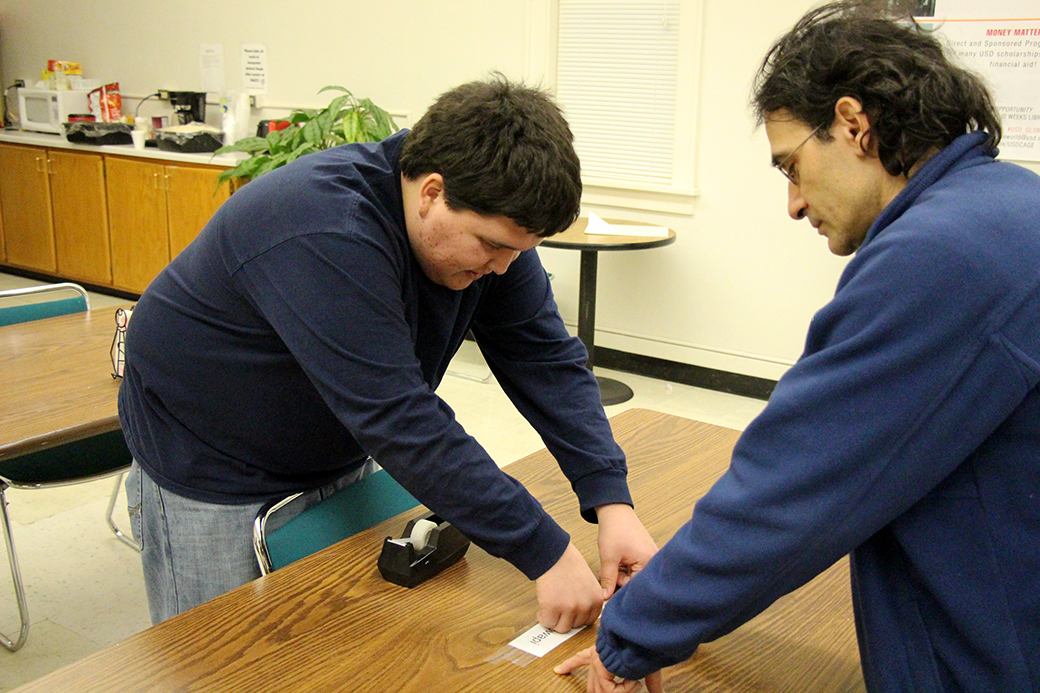
VIDEO: First-year exceeds expectations in Lakota class
USD to offer unique Native American language studies degree next fall, pending SDBOR approval
Colton Sierra hopes to one day start his own business. But if that doesn’t work out the way he’s imagined, he’s counting on his culture to construct a life-long, fulfilling career.
Sierra, a first-year business major with an undecided specialization, is enrolled in the Lakota 102 class taught by Armik Mirzayan at the University of South Dakota. He is among about eight other students learning how to speak the language, which is becoming less common.
“As I found myself, I picked up this desire and need to learn the language,” Sierra said. “If I don’t like the business stuff or don’t have enough money to start my own business, I can get certified to teach (Lakota).”
Sierra, a member of the Pine Ridge Indian Reservation in western South Dakota, decided to take Lakota language courses at USD because he was interested in learning more about his Oglala Lakota heritage and was inspired by his high school language instructors to continue learning Lakota. But when enrolling in the language course for the spring semester, Sierra surprised Mirzayan and a few officials from the advising office.
“When I talked to him it was pretty obvious (he knew the language),” Mirzayan said. “We don’t have placement exams, and usually it’s all oral. When you talk with someone, you get an idea of where you are. He could have almost skipped the first year and gone onto the second year.”
Sierra is the first student at USD to advance-place straight into Lakota 102. Sierra said he had not anticipated skipping 101 and jumping right into 102, but is excited that he is able to learn the language and push himself.
Mirzayan said most of the students who come into his Lakota language classes have very little exposure to the language, and those that do have little skill set with the language.
“For most of the students, the only exposure they’ve had is from 101,” he said. “We do have students that have sometimes seen the language and heard it, but for others it’s their first time.”
Mirzayan said a common struggle for English speakers learning the Lakota language is pronunciation. He said a main focus at the beginning of his 101 class is making sure students have a basic understanding of Lakota phonetics and pronunciation.
“Every language has its difficulties, so there’s no such thing as an easy language,” Mirzayan said.
In his 102 class, Mirzayan said he focusses a lot on things like speaking, role play and word puzzles to better engage his students. Because of Sierra’s advanced skill level, Mirzayan said Sierra is helping push his classmates to their limits.
“He’s helped me establish a link with other students. They have another model to listen to, not just me,” Mirzayan said. “His pronunciation is almost as good as a native speaker. Even though he may not know the vocabulary and grammar, he knows the basics and that’s a really good model for the other students.”
Expanding the program
Laura Vidler, chair of the modern languages and linguistics department, is hoping adding new major and minor programs in Lakota will help to ignite more interest.
A bachelor’s degree in Native American Studies with a specialization in the Lakota language is set to become available next fall, pending the approval of the South Dakota Board of Regents. The degree will be a collaborative, interdisciplinary effort between the language, anthropology and history departments, Vidler said.
“We’re hoping the new program will help to generate interest so we can justify enrollment in more advanced (Lakota) classes,” she said. “It’s incredibly important to not only the heritage and history of South Dakota, but also for the future of South Dakota.”
The new Native American Studies program is something Sierra is hoping to pursue as a minor.
“It’d be really fun,” he said. “I’d probably start teaching at home.”
Mirzayan said the new program may serve as a way to not only educate people more about Native American culture and Lakota language, but convey the message that there is still a strong interest among people wanting to preserve the history and carry it out.
“There’s this perspective from the outside that there’s not too many speakers, and there aren’t usually,” Mirzayan said. “But the language is not dead, it’s not an artifact — there are people who speak the language.”
Sierra plans to carry out this work and spread knowledge about the Lakota language back home. He said learning the Lakota language has helped him better connect with his heritage, and we wants to evoke that same feeling in others.
“I want to be the push to getting my whole people started with learning the language and back towards having the whole Pine Ridge Reservation bilingual, and then eventually trilingual. That’s my big end goal,” Sierra said.
(Photo: First-year student Colton Sierra and professor Armik Mirzayan place sheets of paper with Lakota words symbolizing objects in the Native American Cultural Center March 2. Trent Opstedahl / The Volante)


